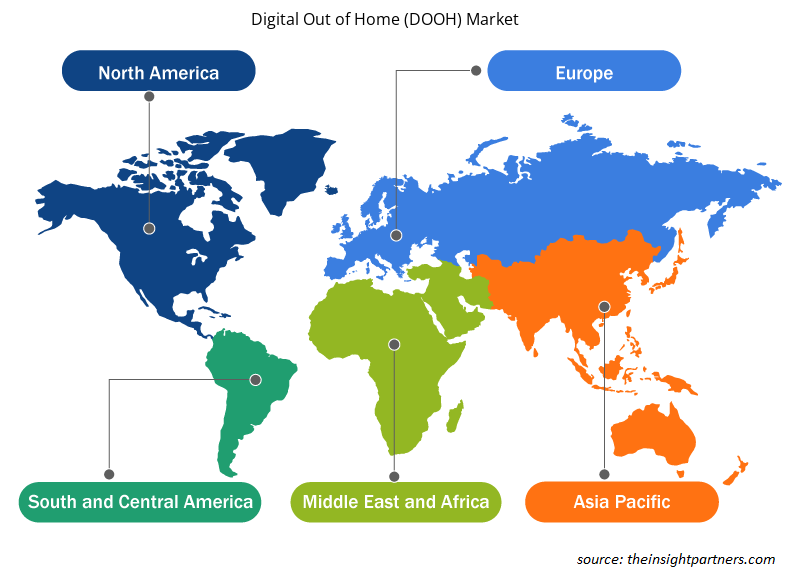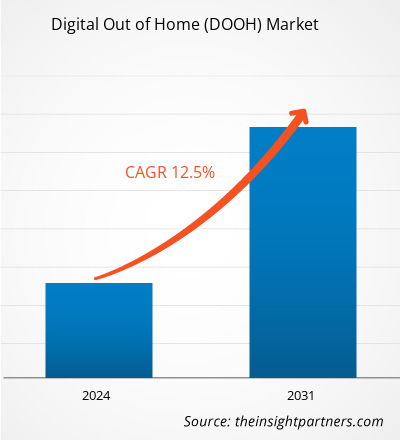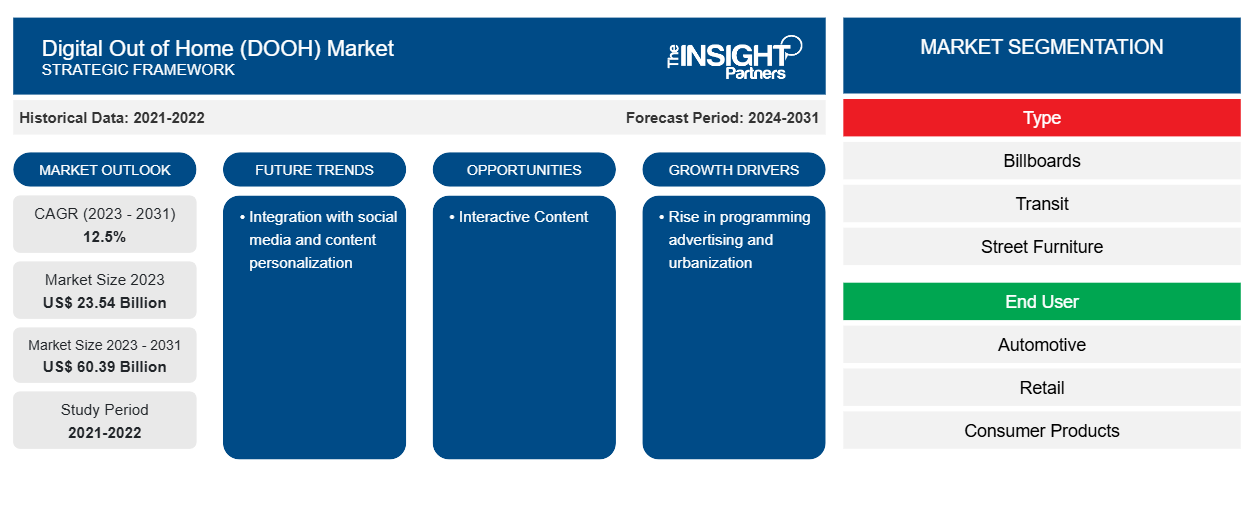Si prevede che la dimensione del mercato Digital Out of Home (DOOH) raggiungerà i 60,39 miliardi di dollari entro il 2031, rispetto ai 23,54 miliardi di dollari del 2023. Si prevede che il mercato registrerà un CAGR del 12,5% nel 2023-2031. È probabile che l'integrazione con i social media e i contenuti interattivi rimangano le tendenze chiave del mercato Digital Out of Home (DOOH).
Analisi del mercato Digital Out of Home (DOOH)
DOOH è un nuovo tipo di media noto come pubblicità esterna o out-of-home (OOH). I media DOOH, al contrario del marketing digitale online e di altri dispositivi, sono visibili su cartelloni pubblicitari, schermi LED e segnaletica digitale in luoghi pubblici ad alto traffico dove le persone trascorrono già del tempo fuori casa. Consente ai venditori di connettersi senza sforzo con i consumatori mentre svolgono le loro attività quotidiane, offrendo contenuti contestualmente rilevanti a target di pubblico su larga scala.
Panoramica del mercato Digital Out of Home (DOOH)
La pubblicità digitale out-of-home (OOH) è diventata una piattaforma sempre più forte e di successo per i marketer per comunicare con i consumatori del mondo reale. Il panorama DOOH è in continuo cambiamento con l'avanzare della tecnologia e il cambiamento dei comportamenti dei consumatori. Uno dei principali vantaggi della pubblicità digitale OOH è la capacità di raccogliere dati e monitorare l'efficacia della campagna.
Personalizza questo report in base alle tue esigenze
Riceverai la personalizzazione gratuita di qualsiasi report, comprese parti di questo report, o analisi a livello nazionale, pacchetto dati Excel, oltre a usufruire di grandi offerte e sconti per start-up e università
-
Scopri le principali tendenze di mercato in questo rapporto.Questo campione GRATUITO includerà analisi di dati che spaziano dalle tendenze di mercato alle stime e alle previsioni.
Driver e opportunità del mercato Digital Out of Home (DOOH)
Aumento della pubblicità programmatica per favorire il mercato
La pubblicità programmatica sta trasformando il modo in cui gli annunci vengono visualizzati online e sta iniziando a fare lo stesso per gli annunci pubblicati in aree pubbliche. In futuro, la pubblicità programmatica sarà ancora più importante in questi contesti pubblici. Consentirà agli inserzionisti di acquistare e vendere automaticamente spazi pubblicitari in tempo reale. Ciò renderà le cose più facili per loro e consentirà loro di indirizzare le loro pubblicità alle persone giuste al momento giusto. Utilizzando dati e approfondimenti, gli inserzionisti saranno in grado di sviluppare pubblicità mirate che siano pertinenti per le persone che le visualizzano. Ciò si tradurrà in pubblicità più efficaci.
Contenuti interattivi: un’opportunità nel mercato Digital Out of Home (DOOH)
I consumatori sono sempre più alla ricerca di esperienze immersive che vadano oltre la visione passiva. In risposta, la pubblicità OOH incorpora aspetti interattivi per renderla più coinvolgente. Touchscreen, realtà aumentata (AR) e realtà virtuale (VR) vengono incorporati nei display digitali, consentendo ai consumatori di interagire con materiale e aziende in tempo reale.VR) are being incorporated into digital displays, allowing consumers to engage with material and companies in real-time.
Analisi della segmentazione del rapporto di mercato Digital Out of Home (DOOH)DOOH) Market Report Segmentation Analysis
I segmenti chiave che hanno contribuito alla derivazione dell'analisi di mercato del digital out of home (DOOH) sono la tipologia e l'utente finale.
- In base al tipo, il mercato digital out of home (DOOH) è suddiviso in cartelloni pubblicitari, trasporti pubblici, arredo urbano e place-based. Il segmento dei cartelloni pubblicitari ha detenuto la quota maggiore del mercato nel 2023.
- In base all'utente finale, il mercato DOOH (Digital Out of Home) è suddiviso in automotive, vendita al dettaglio, prodotti di consumo, BFSI, telecomunicazioni e altri.
Analisi della quota di mercato del Digital Out of Home (DOOH) per area geografica
L'ambito geografico del rapporto sul mercato Digital Out of Home (DOOH) è suddiviso principalmente in cinque regioni: Nord America, Asia Pacifico, Europa, Medio Oriente e Africa e Sud America/Sud e Centro America.
Il Nord America ha dominato ilMercato Digital Out of Home (DOOH). L'infrastruttura tecnologica avanzata che supporta display di alta qualità sta guidando la domanda di mercati Digital Out of Home (DOOH) nella regione.
Approfondimenti regionali sul mercato Digital Out of Home (DOOH)
Le tendenze regionali e i fattori che influenzano il mercato Digital Out of Home (DOOH) durante il periodo di previsione sono stati ampiamente spiegati dagli analisti di Insight Partners. Questa sezione discute anche i segmenti e la geografia del mercato Digital Out of Home (DOOH) in Nord America, Europa, Asia Pacifico, Medio Oriente e Africa e Sud e Centro America.

- Ottieni i dati specifici regionali per il mercato Digital Out of Home (DOOH)
Ambito del rapporto di mercato Digital Out of Home (DOOH)
| Attributo del report | Dettagli |
|---|---|
| Dimensioni del mercato nel 2023 | 23,54 miliardi di dollari USA |
| Dimensioni del mercato entro il 2031 | 60,39 miliardi di dollari USA |
| CAGR globale (2023-2031) | 12,5% |
| Dati storici | 2021-2022 |
| Periodo di previsione | 2024-2031 |
| Segmenti coperti |
Per tipo
|
| Regioni e Paesi coperti |
America del Nord
|
| Leader di mercato e profili aziendali chiave |
|
Densità degli attori del mercato Digital Out of Home (DOOH): comprendere il suo impatto sulle dinamiche aziendali
Il mercato Digital Out of Home (DOOH) sta crescendo rapidamente, spinto dalla crescente domanda degli utenti finali dovuta a fattori quali l'evoluzione delle preferenze dei consumatori, i progressi tecnologici e una maggiore consapevolezza dei vantaggi del prodotto. Con l'aumento della domanda, le aziende stanno ampliando le loro offerte, innovando per soddisfare le esigenze dei consumatori e capitalizzando sulle tendenze emergenti, il che alimenta ulteriormente la crescita del mercato.
La densità degli operatori di mercato si riferisce alla distribuzione di aziende o società che operano in un particolare mercato o settore. Indica quanti concorrenti (operatori di mercato) sono presenti in un dato spazio di mercato in relazione alle sue dimensioni o al valore di mercato totale.
Le principali aziende che operano nel mercato Digital Out of Home (DOOH) sono:
- Canale libero all'aperto, LLC
- Broadsign International, Inc
- Media in prima linea Inc.
- Samsung Electronics Co. Ltd
- Società pubblicitaria Lamar
- Società NEC
Disclaimer : le aziende elencate sopra non sono classificate secondo un ordine particolare.

- Ottieni una panoramica dei principali attori del mercato Digital Out of Home (DOOH)
Notizie e sviluppi recenti del mercato Digital Out of Home (DOOH)
Il mercato Digital Out of Home (DOOH) viene valutato raccogliendo dati qualitativi e quantitativi post-post-primari e secondari, che includono importanti pubblicazioni aziendali, dati associativi e database. Di seguito è riportato un elenco degli sviluppi nel mercato per il mercato Digital Out of Home (DOOH) e delle strategie:
- Heritage Outdoor Media ha collaborato con Daktronics per creare un cartellone digitale SMD con risoluzione di 8 millimetri sul Bow Tie Building al 1530 Broadway a Times Square, New York. Torkian Group ha anche partecipato all'accordo come locatario al dettaglio per il cartello, noto come cartello "New York, New York", che tenta di sconvolgere l'esperienza DOOH di Times Square incorporando esperienze tecnologiche emergenti come la realtà aumentata e l'interazione mobile. (Fonte: Daktronics, Inc, comunicato stampa, 2022)
Copertura e risultati del rapporto di mercato Digital Out of Home (DOOH)
Il rapporto “Dimensioni e previsioni del mercato Digital Out of Home (DOOH) (2021-2031)” fornisce un’analisi dettagliata del mercato che copre le seguenti aree:
- Dimensioni e previsioni del mercato a livello globale, regionale e nazionale per tutti i segmenti di mercato chiave coperti dall'ambito
- Dinamiche di mercato come fattori trainanti, vincoli e opportunità chiave
- Principali tendenze future
- Analisi dettagliata delle cinque forze PEST/Porter e SWOT
- Analisi di mercato globale e regionale che copre le principali tendenze di mercato, i principali attori, le normative e gli sviluppi recenti del mercato
- Analisi del panorama industriale e della concorrenza che copre la concentrazione del mercato, l'analisi della mappa di calore, i principali attori e gli sviluppi recenti
- Profili aziendali dettagliati
- Analisi storica (2 anni), anno base, previsione (7 anni) con CAGR
- Analisi PEST e SWOT
- Valore/volume delle dimensioni del mercato - Globale, Regionale, Nazionale
- Industria e panorama competitivo
- Set di dati Excel
Report recenti
Testimonianze
Motivo dell'acquisto
- Processo decisionale informato
- Comprensione delle dinamiche di mercato
- Analisi competitiva
- Analisi dei clienti
- Previsioni di mercato
- Mitigazione del rischio
- Pianificazione strategica
- Giustificazione degli investimenti
- Identificazione dei mercati emergenti
- Miglioramento delle strategie di marketing
- Aumento dell'efficienza operativa
- Allineamento alle tendenze normative























 Ottieni un campione gratuito per - Mercato Digital Out of Home (DOOH)
Ottieni un campione gratuito per - Mercato Digital Out of Home (DOOH)